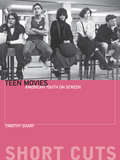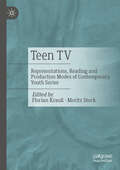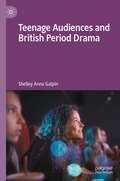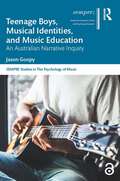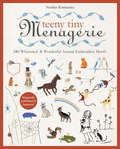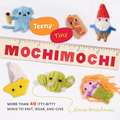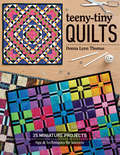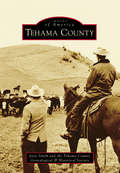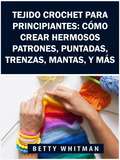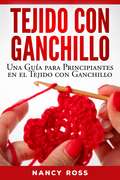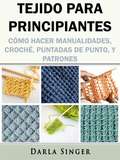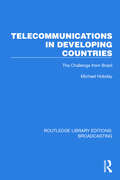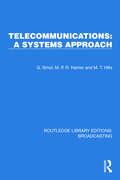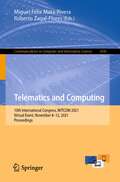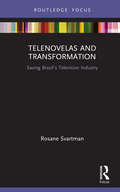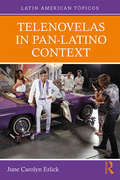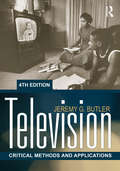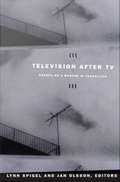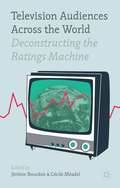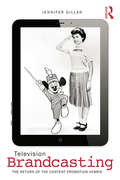- Table View
- List View
Teen Movies: American Youth on Screen (Short Cuts)
by Timothy Shary Rob McInnesTeen Movies: American Youth on Screen is a detailed look at the depiction of teens on film and its impact throughout film's history. Timothy Shary looks at the development of the teen movie – the rebellion, the romance, the sex and the horror – up to contemporary portrayals of ever-changing youth. Films studied include Rebel Without a Cause (1955), Splendor in the Grass (1961), Carrie (1976), The Breakfast Club (1985), and American Pie (1999).
Teen TV: Representations, Reading and Production Modes of Contemporary Youth Series
by Florian Krauß Moritz StockTeen TV is booming. Current youth series on streaming platforms are a clear indication of this, but have so far received little attention in German-language media studies. This anthology provides a fundamental introduction to serial teen TV and takes a look at central case studies, from 13 Reasons Why to DRUCK, the German adaptation of the Norwegian transmedia youth drama SKAM. In addition to the content and aesthetics of serial teen narratives, it looks at their reception and production contexts.
Teen TV: Repräsentationen, Lesarten und Produktionsweisen aktueller Jugendserien
by Florian Krauß Moritz StockDas Teen TV boomt. Aktuelle Jugendserien auf Streaming-Plattformen sind dafür ein klares Indiz, haben in der deutschsprachigen Medienwissenschaft bislang aber kaum Beachtung gefunden. Dieser Sammelband führt grundlegend in das serielle Teen TV ein und nimmt zentrale Fallbeispiele in den Blick, von 13 Reasons Why bis zu DRUCK, der deutschen Adaption des norwegischen Transmedia-Jugenddramas SKAM. Neben den Inhalten und der Ästhetik der seriellen Jugendnarrationen geht es um ihre Rezeption und um Produktionskontexte.
Teenage Audiences and British Period Drama
by Shelley Anne GalpinThis book provides an engaging insight into the responses of teenage audiences to British period drama, presenting original data collected from young people across England. Situated in relation to debates regarding the heritage film and young people’s consumption of the media, Teenage Audiences and British Period Drama challenges the often homogenous characterisation of teenagers by demonstrating the range of responses this genre inspires in young viewers. Arguing for the period drama’s underestimated relevance to younger audiences, the book details the varied ways that young people use film and television drama to make sense of the world and their place in it, and highlights the under-researched significance of collective viewing in influencing viewer response. Analysis demonstrates the key role that values play in influencing judgements amongst youth audiences, the importance of perceived historical accuracy and the potential for screen texts to inspire a deeper relationship with the past.
Teenage Boys, Musical Identities, and Music Education: An Australian Narrative Inquiry (ISSN)
by Jason GoopyMusic is a powerful process and resource that can shape and support who we are and wish to be. The interaction between musical identities and learning music highlights school music education’s potential contributions and responsibilities, especially in supporting young people’s mental health and well-being. Through the distinctive stories and drawings of Aaron, Blake, Conor, Elijah, Michael, and Tyler, this book reveals the musical identities of teenage boys in their final year of study at an Australian boys’ school.This text serves as an interface between music, education, and psychology using narrative inquiry. Previous research in music education often seeks to generalise boys, whereas this study recognises and celebrates the diverse individual voices of students where music plays a significant role in their lives. Adolescent boys’ musical identities are examined using the theories of identity work and possible selves, and their underlying music values and uses are considered important guiding principles and motivating goals in their identity construction. A teaching and learning framework to shape and support multiple musical identities in senior secondary class music is presented.The relatable and personal stories in this book will appeal to a broad readership, including music teachers, teacher educators, researchers, and readers interested in the role of music in our lives. Creative and arts-based research methods, including narrative inquiry and innovative draw and tell interviews, will be particularly relevant for research method courses and postgraduate research students.
Teeny Tiny Menagerie: 380 Whimsical & Wonderful Animal Embroidery Motifs
by Noriko KomurataStitch 380 adorable animals and a few surprises with detailed, easy-to-follow instructions.Let your imagination run wild with this collection of nearly 400 enchanting animal embroidery motifs. Using traditional embroidery, cross-stitch, and applique techniques, you can create a menagerie of motifs, borders, and alphabets unlike any you’ve seen before. Each stitched motif is accompanied by detailed instructions for fuss-free execution. The collection includes an embroidery how-to tutorial and an adorable photo gallery to inspire you to use these designs in innovative ways.• At last, this cute collection of Japanese embroidered animal motifs is finally available in the United States!• From animals and insects to borders and alphabet letters, you can pick, choose, and even combine elements to make a one-of-a-kind embroidered motif• These original creatures are the perfect way to add a personal touch to any item
Teeny-Tiny Mochimochi: More Than 40 Little Bitty Minis to Knit, Wear, and Give
by Anna HrachovecThis title is suitable for advanced beginner to intermediate-level knitters who want fun, witty, irresistibly tiny patterns to make as gifts for friends, cute accessories and decorative items. In "Teeny-Tiny Mochimochi", toy knits designer Anna Hrachovec presents more than 30 super-cute, humorous patterns for miniature toys, plus techniques for tiny knitting; ideas for using the tiny knits as wearables, decorations and gifts; and instructions on how to convert a pattern for a tiny project into a bigger toy.
Teeny-Tiny Quilts: 35 Miniature Projects—Tips & Techniques for Success
by Donna Lynn ThomasMaster the precision and attention to detail needed for quilts—in sizes small, smaller, and smallest! In this book, author Donna Lynn Thomas teaches you the skills you need to create accurately pieced quilts in miniature. Choosing fabrics (with emphasis on print size), cutting (with emphasis on accuracy), sewing (with techniques for how to sew small pieces and tiny half-square triangles), pressing, and finishing are all covered in depth. Build your confidence and skills at your own pace with easy-to-follow instructions and a progression of twelve main projects, from easier to more challenging. Plus, each project comes in up to three sizes, so you can choose how small you want to go!
Tehama County: 150 Years Of Photos And History (Images of America)
by Josie Smith Tehama County Genealogical Historical SocietyTehama County--its name is a mystery but its sense of place is not. The county portrays a friendly Norman Rockwell-like America, with everything from May Day picnics and parades to fall harvests, rugged lumbermen, tough cowboys, and rodeo roundups. Carved out of three Northern California counties in 1856, Tehama County is largely rural, with fertile open spaces dominated by ranching and agriculture. To the east and west are lofty mountains and deep-set canyons sculpted by fast-moving streams to delight recreationists. These streams tumble into the mighty Sacramento River that courses through the middle of the county on its way to the Pacific Ocean. While rural, Tehama County has a rich and colorful heritage reflected in its people. Some of the more notable residents have included Ishi, a Yahi Indian considered the last of his people; William B. Ide, commander in chief of the brief Bear Flag Republic; and railroad magnate and governor of California, Leland Stanford, who built the largest vineyard and brandy distillery in the world here.
Tehran: From Sacred to Radical (Built Environment City Studies)
by Asma MehanThis book is an interdisciplinary research work designed to be of interest to a broad range of academics. The book examines the relationship between democracy and the (trans)formations of urban spaces through comparative perspective. It engages with the ideas of ‘modernity’ in architecture and investigates how they might align (or not) with other forms of radical power. This book offers an understanding of the public spaces through political change, power struggle, and autocratic modernity manifested. It addresses the subject of politics in architecture and built environment by examining the various academic literature in urban studies, architectural history, urban anthropology, urban sociology, cultural geographies, planning history, philosophy, and the broader social and political sciences. Followingly, it will be focused on the less well-known traditions of architecture and democratic values drawing upon western and (non)western perspectives to decolonize the notion of public space in the global south. In better words, the book investigates the mechanisms of power struggles and the transformative dynamism of totalization and state-led modernization, which motivates or shapes a creative tension in the form of the city. The topic of the work is novel and aims to examine the relationship between the affordances of public spaces, their micro-histories, and the emergence of critical social events and movements. The breadth of the topic demanded engagement with a rich body of architectural theory and history and relevant texts in urban sociology, colonial and postcolonial studies, political geography, and cultural studies, a challenge to which the book has responded outstandingly. The issue is urgent for policymakers and architects, urban designers, political and cultural geographers, and other practitioners working on the built environment to create more democratic public spaces in the global south.
Tejido Crochet para principiantes: Cómo crear hermosos patrones, puntadas, trenzas, mantas, y más
by Betty Whitman Diego Romero¿Te gusta tejer o te gustaría aprender cómo? ¡Aprenda a crear bellos patrones en muy poco tiempo! Ya sea que esté de viaje, en su casa o en cualquier otro lugar, puede tejer en su tiempo libre, en cualquier lugar que desee. - Haz patrones en solo unas pocas horas. - Aprende a hacer tejer. - Aprende patrones de puntadas. - ¡Crea sombreros, suéteres, calcetines, regalos, artículos para tu hogar y muchos más! >>> Solicite su copia al instante
Tejido con Ganchillo: Una Guía para Principiantes en el Tejido con Ganchillo
by Nancy RossDescripción del Libro: ¡DESCUBRA UNA FORMA FÁCIL DE EMPEZAR A TEJER CON GANCHILLO! Ya sea que quiere aprender los pasos básicos para comenzar a tejer con ganchillo, para aliviar estrés, o sólo por el placer de hacerlo, este libro lo puede ayudar. Aquí tiene un adelanto de lo que aprenderá… Los pasos básicos que necesitara para comenzar a tejer con ganchillo. Aprenderá algunos de los puntos básicos Disminuciones Aumentos Unir hilos Cerrar el tejido ¡Y mucho, mucho más!
Tejido para Principiantes: Cómo Hacer Manualidades, Croché, Puntadas de Punto, y Patrones
by Darla Singer Luz Alejandra Magre Colorado¿Disfrutas tejer o te gustaría aprender cómo hacerlo? ¡Aprende a crear hermosos patrones en poco tiempo! Ya sea que estés en carretera, en casa, o en cualquier sitio donde puedas tejer en tu tiempo libre, donde quieras. - Haz patrones en un par de horas. - Aprende cómo tejer. - Aprende patrones de puntadas. - ¡Crea sombreros, suéters, calcetines, regales, objetos para tu hogar, y mucho más! >>> Ordena Tu Copia al Instante
Tele-ology: Studies in Television
by John HartleyTeleology brings together John Hartley's work on television. The book draws on current critical theory in cultural studies to develop a wide-ranging and thought-provoking view of television broadcasting in Britain, Australia and the USA.Neighbours, Hancock's Half Hour, Dallas, Monty Python, Miami Vice, Beverly Hillbillies and Bonanza are among the examples of TV art that are discussed in Hartley's exploration of cultural politics. He takes in TV truth and propaganda; populism in the news; mythologies of the audience; TV drama as a `photopoetic' genre in the tradition of Shakespeare; Kylie Minogue, Madonna and gardening shows.
Telecommunications and the City: Electronic Spaces, Urban Places
by Steve Graham Simon MarvinTelecommunications and the City provides the first critical and state-of-the-art review of the relations between telecommunications and all aspects of city development and management.Drawing on a range of theoretical approaches and a wide body of recent research, the book addresses key academic and policy debates about technological change and the future of cities with a fresh perspective. Through this approach, the complex and crucial transformations underway in cities in which telecommunications have central importance are mapped out and illustrated. Key areas where telecommunications impinge on the economic, social, physical, enviromental and institutional development of cities are illustrated by using boxed extracts and wide range of case study examples from Europe, Japan and North America.Rejecting the extremes of optimism and pessimism in current hype about cities and telecommunications, Telecommunications and the City offers a sophisticated new perspective through which city-telecommunications relations can be understood.
Telecommunications in Developing Countries: The Challenge from Brazil (Routledge Library Editions: Broadcasting #34)
by Michael HobdayTelecommunications in Developing Countries (1990) stresses the importance of modern, micro electronics-based telecommunications for developing economies in providing a basic communications infrastructure for economic and industrial development and the springboard for new information technology activities. Although progress in telecommunications has so far been concentrated in the most advanced regions of the world, some developing countries can bypass older, less efficient forms of telecommunications and go straight to microelectronic technology. This book is the first to examine the challenges and difficulties facing developing countries in this field. extending existing theories of technology transfer and diffusion, Michael Hobday offers an explanation of the forces for change in the telecommunications industry. He then examines Brazil's experience in telecommunications, from developing the technology and building up a modern infrastructure to controlling multinational suppliers of equipment. Dr Hobday explains why Brazil's efforts in this area have succeeded, and offers lessons for other developing countries.
Telecommunications: A Systems Approach (Routledge Library Editions: Broadcasting #33)
by G. Smol M.P.R. Hamer M.T. HillsTelecommunications: A Systems Approach (1976) uses two extended case studies, of public telephone and television systems, in order to introduce the basic ideas of telecommunication systems. It describes the application of a number of techniques within the context of practical telecommunications systems, and takes into account the needs of the users of these systems and the economic constraints which affect the choice of techniques and the overall system structure.
Telematics and Computing: 10th International Congress, WITCOM 2021, Virtual Event, November 8–12, 2021, Proceedings (Communications in Computer and Information Science #1430)
by Roberto Zagal-Flores Miguel Félix Mata-RiveraThis book constitutes the thoroughly refereed proceedings of the 10th International Congress on Telematics and Computing, WITCOM 2021, held in November 2021. Due to the COVID-19 pandemic the conference was held online. The 12 full papers and 7 short papers in this volume were carefully reviewed and selected from 48 submissions. The papers are focused on the topics of deep and machine learning, cybersecurity, wireless networks, computer vision, communications, and education applied to different sceneries of study and COVID-19.
Telemodernities: Television and Transforming Lives in Asia
by Fran Martin Wanning Sun Tania LewisYoga gurus on lifestyle cable channels targeting time-pressured Indian urbanites; Chinese dating shows promoting competitive individualism; Taiwanese domestic makeover formats combining feng shui with life planning advice: Asian TV screens are increasingly home to a wild proliferation of popular factual programs providing lifestyle guidance to viewers. In Telemodernities Tania Lewis, Fran Martin, and Wanning Sun demonstrate how lifestyle-oriented popular factual television illuminates key aspects of late modernities in South and East Asia, offering insights not only into early twenty-first-century media cultures but also into wider developments in the nature of public and private life, identity, citizenship, and social engagement. Drawing on extensive interviews with television industry professionals and audiences across China, India, Taiwan, and Singapore, Telemodernities uses popular lifestyle television as a tool to help us understand emergent forms of identity, sociality, and capitalist modernity in Asia.
Telenovelas and Transformation: Saving Brazil’s Television Industry (Routledge Advances in Transmedia Studies)
by Rosane SvartmanThis book investigates how telenovelas may be the key to the future of Brazilian television and how this content can survive in an interconnected media landscape. Recognised telenovela writer and scholar Rosane Svartman considers the particular characteristics of the telenovela format – number of episodes, melodrama influence, and influence of the audience on future writing – to explore how these can be preserved on multimedia platforms, and the challenges this change may present. Svartman further charts the transformations of the telenovela throughout its history and its major influences and unveils the main storytelling elements and writing processes. Chapters examine the business model of Brazilian corporate television within the current context of hypermedia and analyse how this relationship evolves as it is influenced by the new interactive tools and technologies that amplify the audience’s power. Merging empirical practices and theory, this book will be of great interest to scholars and students of transmedia storytelling, television studies, and Latin American media, as well as professionals working in these areas.
Telenovelas in Pan-Latino Context (Latin American Tópicos)
by June Carolyn ErlickThis concise book provides an accessible overview of the history of the telenovela in Latin America within a pan-Latino context, including the way the genre crosses borders between Latin America and the United States. Telenovelas, a distinct variety of soap operas originating in Latin America, take up key issues of race, class, sexual identity and violence, interweaving stories with melodramatic romance and quests for identity. June Carolyn Erlick examines the social implications of telenovela themes in the context of the evolution of television as an integral part of the modernization of Latin American countries.
Television
by Jeremy G. ButlerFor nearly two decades, Television: Critical Methods and Applications has served as the foremost guide to television studies. Designed for the television studies course in communication and media studies curricula, Television explains in depth how television programs and commercials are made and how they function as producers of meaning. Author Jeremy G. Butler shows the ways in which camera style, lighting, set design, editing, and sound combine to produce meanings that viewers take away from their television experience. He supplies students with a whole toolbox of implements to disassemble television and read between the lines, teaching them to incorporate critical thinking into their own television viewing. The fourth edition builds upon the pedagogy of previous editions to best accommodate current modes of understanding and teaching television. Highlights of the fourth edition include: New chapter and part organization to reflect the current approach to teaching television--with greatly expanded methods and theories chapters. An entirely new chapter on modes of production and their impact on what you see on the screen. Discussions integrated throughout on the latest developments in television's on-going convergence with other media, such as material on transmedia storytelling and YouTube's impact on video distribution. Over three hundred printed illustrations, including new and better quality frame grabs of recent television shows and commercials. A companion website featuring color frame grabs, a glossary, flash cards, and editing and sound exercises for students, as well as PowerPoint presentations, sample syllabi and other materials for instructors. Links to online videos that support examples in the text are also provided. With its distinctive approach to examining television, Television is appropriate for courses in television studies, media criticism, and general critical studies.
Television After TV: Essays on a Medium in Transition
by Lynn Spigel Jan OlssonIn the last ten years, television has reinvented itself in numerous ways. The demise of the U. S. three-network system, the rise of multi-channel cable and global satellite delivery, changes in regulation policies and ownership rules, technological innovations in screen design, and the development of digital systems like TiVo have combined to transform the practice we call watching tv. If tv refers to the technologies, program forms, government policies, and practices of looking associated with the medium in its classic public service and three-network age, it appears that we are now entering a new phase of television. Exploring these changes, the essays in this collection consider the future of television in the United States and Europe and the scholarship and activism focused on it. With historical, critical, and speculative essays by some of the leading television and media scholars, Television after TV examines both commercial and public service traditions and evaluates their dual (and some say merging) fates in our global, digital culture of convergence. The essays explore a broad range of topics, including contemporary programming and advertising strategies, the use of television and the Internet among diasporic and minority populations, the innovations of new technologies like TiVo, the rise of program forms from reality tv to lifestyle programs, television's changing role in public places and at home, the Internet's use as a means of social activism, and television's role in education and the arts. In dialogue with previous media theorists and historians, the contributors collectively rethink the goals of media scholarship, pointing toward new ways of accounting for television's past, present, and future. Contributors William Boddy Charlotte Brunsdon John T. Caldwell Michael Curtin Julie D'Acci Anna Everett Jostein Gripsrud John Hartley Anna McCarthy David Morley Jan Olsson Priscilla Pea Ovalle Lisa Parks Jeffrey Sconce Lynn Spigel William Uricchio
Television Audiences Across the World: Deconstructing the Ratings Machine
by Cécile Méadel Jérôme BourdonThis book is the first to deal with the world composition of television ratings. It focuses on the peoplemeter, a 25 year old technology which succeeds in homogenizing very different populations and television practices. It provides a fascinating account of the production of figures on which the whole world of popular culture depends.
Television Brandcasting: The Return of the Content-Promotion Hybrid
by Jennifer GillanTelevision Brandcasting examines U. S. television’s utility as a medium for branded storytelling. It investigates the current and historical role that television content, promotion, and hybrids of the two have played in disseminating brand messaging and influencing consumer decision-making. Juxtaposing the current period of transition with that of the 1950s-1960s, Jennifer Gillan outlines how in each era new technologies unsettled entrenched business models, an emergent viewing platform threatened to undermine an established one, and content providers worried over the behavior of once-dependable audiences. The anxieties led to storytelling, promotion, and advertising experiments, including the Disneyland series, embedded rock music videos in Ozzie & Harriet, credit sequence brand integration, Modern Family’s parent company promotion episodes, second screen initiatives, and social TV experiments. Offering contemporary and classic examples from the American Broadcasting Company, Disney Channel, ABC Family, and Showtime, alongside series such as Bewitched, Leave it to Beaver, Laverne & Shirley, and Pretty Little Liars, individual chapters focus on brandcasting at the level of the television series, network schedule, "Blu-ray/DVD/Digital" combo pack, the promotional short, the cause marketing campaign, and across social media. In this follow-up to her successful previous book, Television and New Media: Must-Click TV, Gillan provides vital insights into television’s role in the expansion of a brand-centric U.S. culture.
